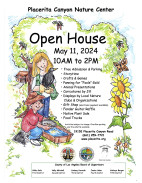The Castaic shelter, run by the Los Angeles County Department of Animal Care and Control, is a stopping ground in many animal journeys. People stop to look for a new friend, or stop to leave an animal because it doesn’t “work” with their family, often bidding them a tearful farewell. Some stop on a regular basis to make donations of goods and services.

Clare Storey, animal shelter volutneer
Then there are those who stop and stay awhile – the strong core of the shelter volunteers.
There are hundreds of volunteers who work in county facilities, and county staff are quick to credit them with the program’s success.
Volunteer Clare Storey works in a scrapbooking store when she’s not with her four-legged charges.
“I go from glycerine glue to puppy poo,” she said.
On Tuesday morning, she got into a cage near the vet’s area to comfort a miniature pincher that was getting ready to give birth. Texting another volunteer, she arranged to take the dog home where they would keep watch on the dog and make sure all the puppies were alright.
All in a day’s work, helping the animals and the shelter’s staff make tight budget dollars go further.
Storey said that her past experience working with a local rescue gave her a somewhat ‘superior’ attitude when it came to “granting” ownership of animals. Most rescues ask applicants to fill out long forms with many questions about the environment, family, time and future for the animals.
“I went to the Found Animals Forum and heard a speaker that really rang home with me,” she explained. “She said that the first thing a rescue group does is slap people with a six-page adoption form; ‘have you got a pool, do you have kids, have you done this, where would your dog sleep, do you work?’ Hell yes, I work, to pay for the dog food!”
“She said the form should have just a few questions: name, address, email if you want to. Will you kill this animal? No? Brilliant! It really brought it home to me that I had been playing god.”
“It took me coming here and speaking to Joe Public,” she continued. “Yes, they need a little education, but when you walk a mile in someone else’s shoes, you realize that things don’t always work out, particularly in this tough economy, there’s a lot of reasons people can’t keep their animals.
Karen Stepp, the Castaic shelter manager, chimed in. “You don’t have to beat people up, especially when they’re giving up their animals, all you have to do is listen to them, sometimes that will turn them around where you know what, maybe I do have options and they’ll do the right thing, or at least they gave it up here, they didn’t dump it out in the street.”
Stepp and Storey both shook their heads recalling the situations that brought many of the animals to the shelter – abandonment, age, unfriendly landlords…
What Storey and the other volunteers have been able to do is network like crazy with rescue groups and animal activists all over the country – and beyond. They recently found someone to drive a Rottweiler and a 100-pound Labrador mix who needed medical care and relocation to San Francisco and Seattle.
“A lady came and said she’d borrow her friend’s Suburban and drive the dogs,” Storey said. “She didn’t want anything for it, either, didn’t ask for a penny for gas money or anything.”
“The volunteers are amazing here in Castaic, we have a lot of communication,” Stepp said. “They go the extra mile with the adoptions, they match the people who are adopting, and they get the animals into the right homes, so if the dog has a few issues, they can call the volunteers personally. They give the adoption a personal touch.”
There are a myriad of special programs aimed at matching the right humans with the right animals, for example, veterans can adopt from a county shelter at no cost and through the end of the year, there’s a Buy One Get One Free on cats – pay for the first, get a second cat (including the spay/neuter and required shots) free.
Dogs are still a bargain at $100, which includes all shots, spay/neuter and microchipping.
“Licensing fees are the only thing we don’t subsidize,” said Stepp. “Just please come on down, take a look and find your new friend here.”
Donations to the shelter come from all sorts of venues, from corporations to rescue groups to individuals who bring in blankets and bags of food and all sorts of goodies.
“We take cat beds, dog beds, towels, newspapers,” Stepp said, ticking off a list of items needed. “We don’t like comforters because the stuffing can come out, but blankets are fine. Wet canned food, we can use that to put pills in, metal bowls, even dog houses. If we can re-gift something, we will do that. For the horses, we’ll take lead ropes, anything. People even bring carrots by so we can give them a treat.
“We try to be more efficient when budgets are tight, but we’re always going to give the animals the basic care,” she continued. “We get a lot of donations, which always help; they subsidize medical care and provide food and supplements.”
Walking around the open campus, Stepp pointed out several other donations, including square planters with tall trees, and murals on nearly every large flat surface.
A recent “Big Sunday” volunteer day resulted in a whole new look for the shelter – all the buildings were painted, some with murals, trees were planted, horse stalls were cleaned and refurbished, landscaping was completely overhauled, including small flowers and low greenery in the turtle pond area, birdhouses made by “the people next door” (inmates at Pitchess Detention Center) were hung and the chicken coop was taken over by the Boy Scouts.
“They redid the whole thing,” Stepp said. “We don’t have any chickens now, but we get everything – turtles, reptiles, snakes.”
The shelter has several “getting to know you areas” where potential adopters can brush the dogs, play with them and get to know them.
“I want this to be a place where people want to come, not be scared to go to the animal shelter,” Stepp said. “I want it to be a place where families can adopt and make it a nice place to come, not the scary old, what people thought it was back in the day. That’s the only way these animals are going to get out of here.”
A small building near the back of the campus is named “The Weste Wing” after Santa Clarita City Councilwoman Laurene Weste, who is an animal advocate and helped establish a sanctuary for cats that was separate from the dog kennels. Once a large, open building, it’s now home to a veterinary suite, two rooms of cages lining the walls for animals due in surgery or under medication, so the humans can keep a watchful eye and a room where cats available for adoption await visitors.

Mural by Jim McCarthy
Weste herself painted some of the decoration on the walls, with her husband, Jim McCarthy, who dabbles in the visual arts, creating a full mural of a cat sitting on a windowsill, gazing off into the distance.
The “getting to know you” room offers benches for the humans, cubbies and platforms for the felines. At first glance, only one or two cats brave the floor to peek at visitors, but once inside, the blankets come alive and little whiskered faces peek out for some attention.
The kennels inside were draped with green garland and red bows. The dogs didn’t seem to notice, most of them looked hopefully at the people walking down the aisle; some of them laying on beds made from heavy canvas and PVC pipe, some standing close enough to get a nose nuzzle as they walked by.
The majority of cages held Chihuahuas, with a few pit bull and German Shepherd mixes interspersed between terriers and Lhasa Apso-type dogs.
While Chihuahuas are the “flavor of the month” – meaning shelters are overwhelmed by their numbers, but pit bulls are still running a close second.
“Regarding Chihuahuas, they are little, they’re supposedly cute and people think they’re going to stay little, but they don’t realize that they can turn into little piranhas.” Stepp said. “They’re not really good with kids all the time, but it just depends…people need to make these animals a part of their family. If they don’t and they just throw it outside, why? You have to make it an integral part of your family.”
“It’s a dog, not an accessory so please treat it like a dog,” Storey added. “People carry them around; what you’re doing is automatically giving it more power than it should have because any dog that’s higher than any other dog is dominating all other animals. It needs to be down on the ground, walked, corrected, able to sniff, able to do what dogs do. If you don’t allow it to be a dog, you end up with this land shark that thinks it’s all that and more. And that’s what we see in the shelter.”
“Working here with all the animals, it’s not an easy job,” Stepp explained. “Volunteering is even harder. Our volunteers work with everybody, we try not to judge and try to make the best matches.”
While she talked, a trembling Chihuahua was curled up next to Stepp’s neck.
“This one was being thrown by an 8-year-old up into a tree. She still trembles, but I can get her to play sometimes. She’s so needy, but she’s one of my saviors.”

Dogs and cats aren't the only rescues at the animal shelter.
She said that the dog came to them when the 8-year-old’s mother admitted to the child mistreating the dog.
“We try – that’s what the volunteers are for – we ask the people coming in to get an animal to take a few days; we try to talk to them, find out what they are looking for. We do a little interview.”
“Adoption counseling,” Clare adds.
“I’ve had volunteers tell people no,” Stepp admitted.
Clare sat up in her chair and said “I once famously told a family that they shouldn’t even have a goldfish. Karen wasn’t too impressed.”
“I don’t condone that,” Stepp said, laughing.
“She told me to please remove my volunteer T-shirt before I ever say anything like that again,” Storey continued. “They came back a couple of times, but I would pounce on them and they stopped coming.
“Senior volunteers, more often than not, would be happier to see someone go home empty-handed” she said. “It sounds awful in a kill shelter, but it means they’ve listened, they’re going to go home and do their research.”
Storey said volunteers refer potential adopters to websites hosted by pet food companies or rescue groups that have information valuable in making a decision.
“I tell them to come back and see me, but let’s be realistic. I’d rather send them home empty-handed the first time. They usually come back with a better idea, they’ve cleared a room and got the supplies. You can’t just take a dog from here and go home, because the dog will be back in 48 hours, having made a mess in one of the rooms, chewed up a sofa, or worse.”
Stepp added, “We try education, and just giving them an overall picture of what they’re really getting into and try to find out what they really want. If it means that the dog doesn’t go with that family, if they’re going to be returned in 48 hours, why put the dog through all that? We don’t normally say no, we just try to make the best match.”
Along with the birdhouses that dot the property, there is another program with the men “next door” that helps Castaic’s adoption success.
“We have a grooming program worked out with them (inmates learn grooming and help clean up some of the dogs left at the shelter); they have helped us get so many more animals adopted out,” Stepp said. “We’re just trying to do everything we can to find them homes.”
Around the back is a horse corral, where six horses were in residence, including two quarterhorses and two thoroughbreds. People looking to adopt horses must fill out an equine application and have a home visit to make sure that there is stable room and that the adopter has permission to have horses on their property.
“Most of the horses here come from bad situations,” Stepp said. “Running in riverbeds, strays, people just turn them loose. We’re found them walking down the street. We got three from a feed store in Acton that someone had just let go. With this economy people can’t afford to feed them. We put weight on them and get them adopted out.”
Stepp has seen a sea change in the public’s attitude toward animal abuse over the 25 years she’s been working with animals.
“It takes a strong will to deal with this sometimes,” she said. “When I started as an Animal Control officer, it was very different. Over 20 million animals were euthanized a year then; now we’ve got it down to 5 (million).”
Castaic – and all the other county shelters – is a kill shelter, which means that as a public entity, they have to take everything that comes through the door without the privilege of turning animals or people away.
“We can’t pick and choose like private rescues,” she said. “But we work with so many rescues that take animals that need work or training. There’s a lot of breed rescues that come and get their breed and adopt them out.
Some breeds have more than one rescue group looking out for them, but Stepp said that a purebred dog may not always be the best fit for a family.
“The best dogs you can get are the mixed breeds,” she said. “They’re loyal, they know you saved them from the pound.”
A kill shelter also means that animals that don’t get adopted are put to sleep. When a stray comes in, staff does a health check and volunteers move in to work with the animals and determine whether it is aggressive or just scared. The animal is kept for five business days in case the owner comes back or someone else wants to adopt them.
“The shelter is trying to mop up what society has left behind,” Storey said. “The animals they won’t train, the animals they dump in the desert, the animals they dump on the roadside. The ones they give up because ‘they’re too old, they can’t take them to the vet.’
“I’m sorry, but if an animal has given you 15 years of its life and all it’s asked for is for food and some loving and the occasional pet, the most important thing you can do for your animal is the thing you do at the end of its life.”
“You give up your Starbucks, you give up your Saturday night dinners out, and you save up and you speak to more than one vet and you take the animal to the vet and have it euthanized in a calm and dignified manner, you do not bring it to the shelter, where, due to the public’s outcry and ignorance, they have to sit her for five business days.”
Stepp explained that shelter staff cannot put an animal down immediately unless the animal is experiencing “irremedial suffering.”
“How do you decide irremedial suffering?” Storey asked. “Animals are very stoic.”
While the kennels are clean and equipped with a bed and blankets, it’s not a home.
“The poor pet doesn’t know it’s been abandoned for five days, they’re going ‘where’s my owner, what happened?’” Stepp said. “They’re in the chaos of the shelter. Every time an animal comes in, the barking erupts. That’s not the place an elderly dog in its final days should be.”
Volunteers’ biggest job at the shelter is to foster animals, including the bottle babies and the ones that wouldn’t necessarily make it. They foster, socialize and acclimate. Stepp said that there are 200 volunteers on the mailing list, but a hard-core group of five regulars and 20 additional volunteers who are at the shelter on an ongoing basis.
Stepp and her corps of staff and volunteers are also doing a lot of image-changing, trying to alter the mindset that the pound is depressing place where animals go to be killed.
Storey may have said it best: “Shelter staff here have to deal with Joe public’s lack of knowledge or care or call it what you will, we still have people out there chaining up six month old puppies. I’ve come down off my rescue mountain, down to the real world and I realize in my dealings with the public who come to the shelter, who come to offsite adoptions, that 99 percent of them are fabulous people. They are caring people, they have chosen to adopt, they have listened to us, they have seen the bumper stickers, for the last 20 years, “Adopt Don’t Shop.” They have listened, they have taken notes, and have made the decision to save a life, which is what adopting a shelter animal does.”
But is all that work worth it?
One of the rewards for both staff and volunteers – and the ones they share and savor – are the large number of people who stop them in the street to show off pictures of rescued animals that came from the shelter, bragging like proud parents.
Volunteer opportunities abound at the shelters; visit their website here at www.animalcare.lacounty.gov. You can also see pictures of adoptable animals at the site.
Like this:
Like Loading...
Related




 Tweet This
Tweet This Facebook
Facebook Digg This
Digg This Bookmark
Bookmark Stumble
Stumble RSS
RSS































REAL NAMES ONLY: All posters must use their real individual or business name. This applies equally to Twitter account holders who use a nickname.
2 Comments
Good story, but why do they still use the wording “putting to sleep”? The animal is being euthanized, it will not wake up from a sleep.
I would like to volunteer at your animal shelter.